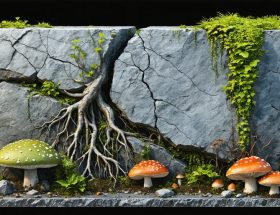Granite, revered for its durability and timeless beauty, faces continuous challenges from both natural and human-induced weathering and erosion processes. Chemical reactions triggered by acid rain dissolve feldspar crystals within granite’s structure, while freeze-thaw cycles exploit existing fissures to gradually break down even the most robust stone formations. Physical weathering from temperature fluctuations causes thermal expansion and contraction, creating microscopic cracks that compromise granite’s integrity over time. Urban environments accelerate these natural processes through pollution, salt exposure, and mechanical stress from daily use. Understanding these weathering mechanisms proves essential for architects, property owners, and stone professionals seeking to protect and preserve granite installations, whether in building facades, countertops, or outdoor monuments. This knowledge enables the implementation of effective preventive measures and maintenance strategies that significantly extend granite’s service life while maintaining its characteristic strength and aesthetic appeal.
Chemical Weathering: The Silent Destroyer
Acid Rain’s Impact
Acid rain poses a significant threat to granite surfaces through a process called chemical weathering. When acidic precipitation interacts with granite, it primarily affects the rock’s feldspar and mica components, while leaving the quartz relatively unchanged. The acid slowly dissolves these minerals, creating microscopic pits and channels in the stone’s surface.
The process begins when sulfuric and nitric acids in rain water react with the calcium and potassium present in granite’s mineral structure. This chemical reaction gradually breaks down the stone’s crystalline matrix, leading to a roughened surface texture and potential color changes. In urban environments, where air pollution levels are higher, this process can be accelerated due to increased acid concentrations in rainfall.
Over time, acid rain can cause granite to develop a chalky appearance and become more porous. This increased porosity makes the stone more susceptible to further weathering and potential structural weakening. While this process occurs very slowly in natural environments, exposure to acid rain can significantly reduce the lifespan of architectural granite elements, particularly in areas with high industrial emissions.
To protect granite surfaces from acid rain damage, regular sealing is essential. Professional-grade sealants create a protective barrier that prevents acidic moisture from penetrating the stone’s surface. Additionally, proper drainage systems and overhangs can help minimize direct exposure to acid rain, thereby extending the life of granite installations.
Mineral Decomposition
Granite’s durability largely depends on the stability of its constituent minerals, with feldspar being particularly susceptible to weathering processes. When exposed to acidic conditions, especially from rainwater or soil acids, feldspar minerals begin to break down into clay minerals like kaolinite. This transformation weakens the stone’s structure and can lead to surface deterioration over time.
The dark mineral components in granite, such as biotite and hornblende, are often the first to show signs of chemical alteration. These minerals can oxidize, creating rust-colored staining and potentially weakening the stone’s surface integrity. The quartz content in granite, however, remains largely resistant to chemical weathering, which explains why granite maintains its structural integrity longer than many other natural stones.
During the decomposition process, the bonds between mineral grains weaken, leading to what geologists call “granular disintegration.” This process can cause individual mineral grains to become loose and eventually separate from the stone’s surface. In outdoor applications, this mineral decomposition is accelerated by exposure to acid rain and other environmental pollutants.
The rate of mineral decomposition varies significantly depending on environmental conditions. Granite used in humid, acidic environments will weather more quickly than stone used in dry, neutral pH conditions. Understanding these processes is crucial for maintaining granite surfaces and implementing appropriate protective measures.

Physical Weathering: Breaking Down From the Outside
Temperature Fluctuations
Temperature fluctuations play a significant role in the weathering of granite through a process known as thermal expansion and contraction. When granite is exposed to heat, its mineral components expand at different rates, creating internal stress within the stone. As temperatures cool, these same minerals contract, again at varying rates. This continuous cycle of expansion and contraction can eventually lead to weakening of the stone’s structure.
During hot summer days, the surface of granite can reach significantly higher temperatures than its interior, particularly in direct sunlight. This temperature differential creates thermal stress that can result in surface cracking or exfoliation, where thin layers of stone begin to peel away. The effect is particularly noticeable in regions with extreme temperature variations between day and night or seasonal changes.
The impact of thermal weathering is often more pronounced at the microscopic level, where it can weaken the bonds between mineral grains. Over time, this weakening can make the granite more susceptible to other forms of weathering, such as chemical and biological processes. In urban environments, dark-colored granite is especially vulnerable to thermal stress due to its higher heat absorption properties.
To minimize the effects of thermal weathering, proper installation techniques that allow for expansion and the use of appropriate sealants can help protect granite surfaces in both interior and exterior applications.
Moisture and Freeze-Thaw Cycles
Water penetration and freeze-thaw cycles represent one of the most significant weathering mechanisms affecting granite surfaces. When water seeps into the microscopic cracks and pores naturally present in granite, it can initiate a destructive cycle, particularly in regions experiencing frequent temperature fluctuations around the freezing point.
During freezing conditions, trapped water expands by approximately 9% in volume. This expansion creates intense pressure within the stone, gradually widening existing fissures and potentially creating new ones. As this process repeats through multiple freeze-thaw cycles, it can lead to progressive deterioration of the granite’s structure, a phenomenon known as frost weathering or cryofracturing.
The severity of moisture-related weathering depends largely on the granite’s porosity and the presence of pre-existing microcracks. Higher-quality granite typically has lower porosity and fewer natural fissures, making it more resistant to freeze-thaw damage. However, even dense granite can become more susceptible to moisture penetration over time as other weathering processes create entry points for water.
To minimize moisture-related weathering, proper sealing of granite surfaces is essential, particularly for outdoor applications. Regular maintenance and resealing help prevent water infiltration, while ensuring adequate drainage around granite installations can reduce prolonged exposure to standing water. In severe climate zones, selecting granite varieties with lower porosity and higher density can provide better long-term resistance to freeze-thaw cycles.

Biological Weathering: Living Threats
Plant and Lichen Growth
Plants and lichens play a significant role in the biological deterioration of stone, including granite. When lichens establish themselves on granite surfaces, they secrete organic acids that gradually break down the stone’s mineral structure. Their root-like structures can penetrate microscopic cracks, expanding them over time and accelerating the weathering process.
Moss and other small plants can take root in these widened cracks, particularly in areas where moisture tends to accumulate. As their roots grow and expand, they create additional pressure that can further split the granite. The presence of these organisms also tends to trap moisture against the stone’s surface, creating conditions that promote chemical weathering and freeze-thaw cycles.
In urban environments, the combination of biological growth and air pollution can be particularly damaging to granite surfaces. The organisms can absorb pollutants and convert them into more aggressive compounds that attack the stone. Regular cleaning and maintenance of granite surfaces, especially in damp or shaded areas, is essential to prevent the establishment and growth of these organisms.

Bacterial Action
Microscopic organisms play a surprisingly significant role in granite weathering through a process known as biodeterioration. Bacteria and lichens that colonize granite surfaces secrete organic acids and other compounds that can gradually break down the stone’s mineral structure. These microorganisms create what scientists call “biofilms” – thin layers of biological material that trap moisture against the stone’s surface and enhance chemical weathering processes.
Common bacteria found on granite surfaces include Thiobacillus and Nitrobacter species, which can oxidize minerals and create acidic conditions that slowly dissolve feldspar and mica components. Lichens, which are actually a symbiotic partnership between fungi and algae, are particularly effective at penetrating microscopic cracks in the granite’s surface, gradually widening them through both chemical and physical processes.
While this biological weathering occurs very slowly compared to other forms of degradation, it’s particularly relevant in humid environments or areas where granite remains damp for extended periods. Regular cleaning and ensuring proper drainage around granite installations can help minimize the impact of bacterial action on the stone’s integrity.
Protecting Your Granite Investment
To effectively maintain your granite’s appearance and protect it from weathering, implementing proper maintenance strategies is essential. Start by applying a high-quality penetrating sealer every 12-24 months, depending on exposure levels. This creates a protective barrier against moisture infiltration while allowing the stone to breathe.
Regular cleaning with pH-neutral stone cleaners prevents the buildup of damaging substances and maintains the sealer’s effectiveness. Avoid acidic or abrasive cleaning products, which can compromise the stone’s surface and accelerate weathering. Address spills immediately to prevent staining and potential chemical reactions.
For exterior applications, ensure proper drainage around granite installations to minimize water exposure. Consider installing copper or zinc strips near the top of granite surfaces, as these metals naturally inhibit biological growth when rainwater washes over them.
Professional evaluation every few years can identify early signs of weathering and determine if restoration work is needed. Small cracks or fissures should be sealed promptly to prevent water infiltration and freeze-thaw damage.
In high-traffic areas or severe weather conditions, consider applying a sacrificial surface coating for additional protection. This coating absorbs wear and tear while protecting the underlying stone and can be renewed as needed without damaging the granite.
By following these preventive measures, you can significantly extend your granite’s lifespan and preserve its natural beauty for decades to come.
Understanding and addressing the various weathering effects on granite is crucial for maintaining its beauty and durability. From chemical deterioration and physical stress to biological factors, each type of weathering can significantly impact granite’s appearance and structural integrity. By implementing proper maintenance routines, using appropriate cleaning products, and taking preventive measures against weathering agents, you can effectively protect your granite surfaces and extend their lifespan for years to come.










